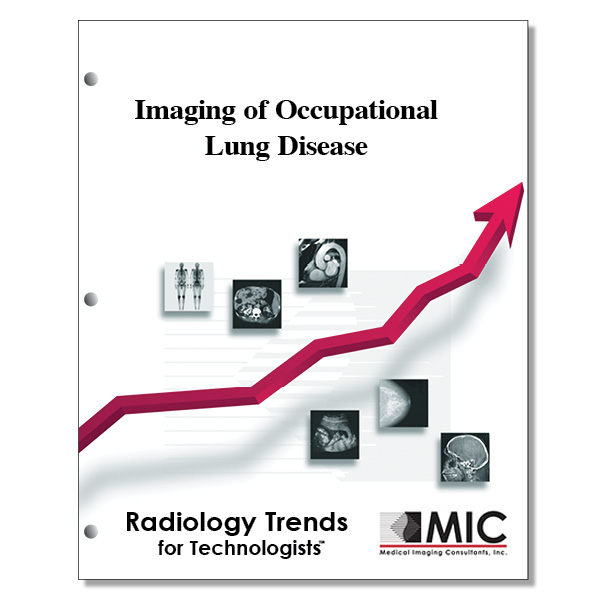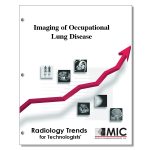

Imaging of Occupational Lung Disease
A multidisciplinary approach to the diagnosis of occupational lung disease is presented.
Course ID: Q00400 Category: Radiology Trends for Technologists Modalities: CT, Radiography3.75 |
Satisfaction Guarantee |
$37.00
- Targeted CE
- Outline
- Objectives
Targeted CE per ARRT’s Discipline, Category, and Subcategory classification for enrollments starting after May 25, 2023:
[Note: Discipline-specific Targeted CE credits may be less than the total Category A credits approved for this course.]
Computed Tomography: 3.00
Patient Care: 1.00
Patient Interactions and Management: 1.00
Procedures: 2.00
Neck and Chest: 2.00
Radiography: 3.75
Patient Care: 1.75
Patient Interactions and Management: 1.75
Procedures: 2.00
Thorax and Abdomen Procedures: 2.00
Registered Radiologist Assistant: 3.75
Patient Care: 1.00
Patient Management: 1.00
Safety: 0.75
Patient Safety, Radiation Protection, and Equipment Operation: 0.75
Procedures: 2.00
Thoracic Section: 2.00
Outline
- Introduction
- Clinical Evaluation
- The Occupational and Environmental Exposure History
- Physical Examination
- Laboratory Testing
- Pulmonary Function Testing
- Bronchoscopy and Surgical Lung Biopsy
- Imaging Technology
- The Radiologistís Role
- Diffuse Pulmonary Opacities
- Nodular Patterns
- Reticular Patterns
- Emphysema and Cysts
- Airway Patterns
- Pleural Patterns
- Major Contemporary Occupational Lung Diseases
- Silicosis
- Coal Workerís Pneumoconiosis
- Asbestos-related Lung and Pleural Disease
- Hypersensitivity Pneumonitis
- Chronic Beryllium Disease
- Emergence of New Occupational Lung Diseases
- Conclusion
Objectives
Upon completion of this course, students will:
- understand the role CT plays in occupational lung disease
- know what an occupational lung disease is
- understand the role chest radiography plays in occupational lung disease
- know why it’s important to relay clinical history and toxin exposure important to the radiologist
- be familiar with the latency periods of various occupational lung disorders
- name the three essential components of an occupational history
- understand how non-occupational lung disorders occur and what toxins are involved
- know what clinical findings at physical exam may be indicative of occupational lung disease
- understand the laboratory tests used to assist in the diagnosis of occupational lung disease
- know how occupational lung diseases may increase a patient’s risk for tuberculosis
- describe the lab tests that can differentiate one occupational lung disorder from another
- understand what type of clinical information a pulmonary function test may provide
- know what type of pulmonary function testing is typically offered in a private practice setting
- describe how occupational lung disease is classified
- be familiar with the results from pulmonary function testing for common occupational lung disorders
- describe the fiberoptic bronchoscopy procedure
- know what occupational lung disorders develop from exposure to asbestos, silica, hard metals, coal dust, and beryllium
- know the characteristics of the lesser known occupational lung disorders, such as berylliosis, talcosis, and calcicosis
- know the standard projections and views recommended by the ACR for chest radiography of common lung disorders
- understand the evaluation criteria and parameters for producing quality chest radiographs
- know what the recommended exposure techniques are for various lung pathologies
- describe the radiographic views and projections that are used in chest radiography, including decubitus, oblique, and apical lordotic views
- know the technical parameters, positions, and dose of a high-resolution CT exam of the lungs
- describe the radiographic appearance of some of the more common occupational lung disorders
- describe how occupational lung injury is categorized
- be familiar with the benefits and limitations of conventional chest radiography in diagnosing occupational lung disease
- know the general patterns of abnormalities seen on CT
- know what medical imaging protocols and exams are beneficial in evaluating post-operative complications
- be familiar with the appearance of common occupational lung disorders on CT
- know what lung diseased were seen in soldiers returning from Iraq and Afghanistan
- know the limitations of conventional chest radiography in imaging occupational lung disease
- know the radiographic criteria for producing a high quality radiograph for pneumoconiosis
- know what the proposed International Classification of HRCT for Occupational and Environmental Respiratory Diseases is
- know what the average radiation dose is for reduced dose CT
- be familiar with the radiographic patterns associated with diffuse pulmonary opacities, reticular, nodular, airway and pleural patterns, emphysema and cysts
